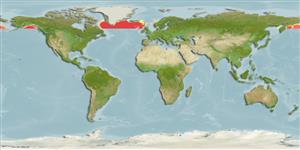Environment: milieu / climate zone / depth range / distribution range
Ecologia
marino batipelagico; distribuzione batimetrica 500 - 7625 m (Ref. 58426), usually 1200 - 1400 m (Ref. 559). Deep-water; 67°N - 56°N, 180°W - 180°E
Circumglobal: In tropical to temperate waters. Eastern Pacific: ranges from northern California to Peru (Ref. 35600).
Size / Peso / Age
Maturity: Lm ? range ? - ? cm
Max length : 100.0 cm TL maschio/sesso non determinato; (Ref. 27000); common length : 55.0 cm NG maschio/sesso non determinato; (Ref. 5755)
Spine dorsali (totale): 0; Spine anali 0. Mouth greatly enlarged by a backward extension of jaws, gape comprising half or more of preanal length; buccal cavity greatly distensible. Tail attenuated and ending in an expanded, luminous caudal organ. Caudal fin absent; scales absent; lateral line without pores, instead with groups of elevated tubules.
Meso- to abyssopelagic (Ref. 58302) and bathypelagic (Ref. 58426). Adults feed mainly on crustaceans, but also take fishes, cephalopods, and other invertebrates (Ref. 2850, 11041). Oviparous, planktonic eggs hatch into planktonic leptocephalus larvae (Ref. 6719, 35600). Degenerative changes in males and females suggest semelparity (Ref. 35600).
Life cycle and mating behavior
Maturità | Riproduzione | Deposizione | Uova | Fecundity | Larve
Oviparous (Ref. 35600). Degenerative changes in males and females suggest semelparity (Ref. 35600). Egg cells within each of the gonads have the same developmental stage (monocyclic ovaries) suggesting only one spawning during its lifetime or periodic spawning (Ref. 36055).
Nielsen, J.G. and E. Bertelsen, 1990. Eurypharyngidae. p. 206. In J.C. Quero, J.C. Hureau, C. Karrer, A. Post and L. Saldanha (eds.) Check-list of the fishes of the eastern tropical Atlantic (CLOFETA). JNICT, Lisbon; SEI, Paris; and UNESCO, Paris. Vol. 1. (Ref. 4457)
IUCN Red List Status (Ref. 130435)
Threat to humans
Harmless
Human uses
Pesca: di nessun interesse
Strumenti
Special reports
Download XML
Fonti Internet
Estimates based on models
Preferred temperature (Ref.
123201): 2.3 - 5.5, mean 3.6 °C (based on 890 cells).
Phylogenetic diversity index (Ref.
82804): PD
50 = 1.5000 [Uniqueness, from 0.5 = low to 2.0 = high].
Bayesian length-weight: a=0.00102 (0.00046 - 0.00225), b=3.06 (2.88 - 3.24), in cm total length, based on all LWR estimates for this body shape (Ref.
93245).
Trophic level (Ref.
69278): 4.1 ±0.57 se; based on food items.
Resilienza (Ref.
120179): Molto basso, tempo minimo di raddoppiamento della popolazione più di 14 anni (Assuming semelparity with tm>10).
Fishing Vulnerability (Ref.
59153): High vulnerability (60 of 100).
Nutrients (Ref.
124155): Calcium = 15.6 [4.0, 64.6] mg/100g; Iron = 0.408 [0.125, 1.243] mg/100g; Protein = 2.94 [0.00, 6.86] %; Omega3 = 0.192 [0.063, 0.599] g/100g; Selenium = 18.7 [6.0, 72.0] μg/100g; VitaminA = 28.8 [3.8, 214.8] μg/100g; Zinc = 0.453 [0.206, 1.092] mg/100g (wet weight);
